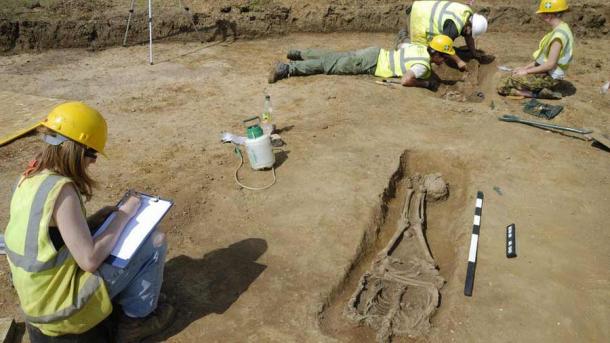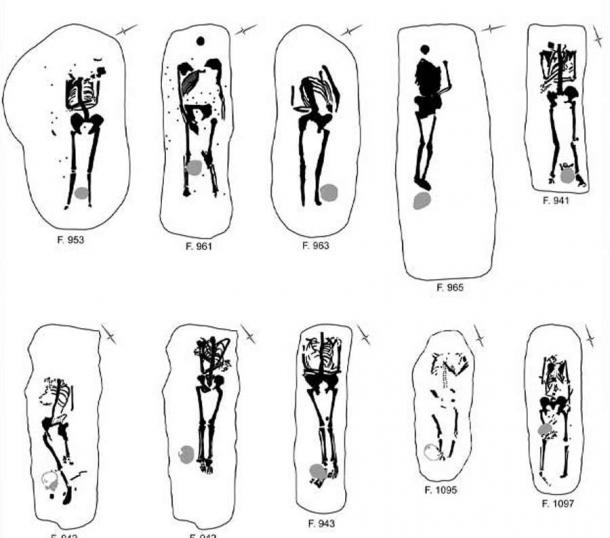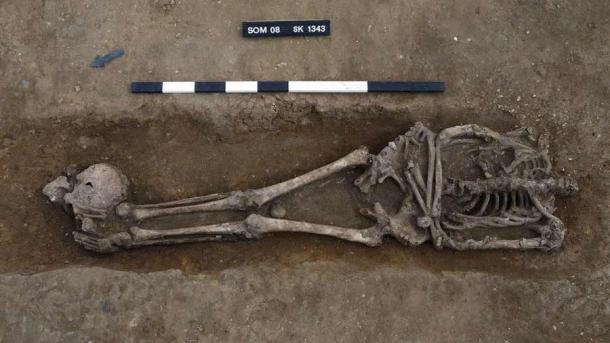It wouldn’t be unfair to say that the Roman Empire was a vast intercontinental territory. By 117 AD, it included all of Italy, the entire Mediterranean, and much of Europe, including England, Wales and Scotland. At Knobb’s Farm, Somersham, Cambridgeshire, three Roman burial sites have revealed an unusually high number of Roman decapitations, much higher than the average at most British Roman cemeteries. The fascinating study of the Roman decapitations in Somersham were recently published by the Cambridge University Press .
Roman Decapitations In The Ancient Graves at Knobb’s Farm
The Knobb’s Farm Roman burials dated to the late Roman Empire (the 3rd century AD), were victims of Roman military executions, most probably judicially sanctioned. They lay kneeling with their backs to the executor, and then were struck from behind with a sword, according to the BBC.
The average for Roman-style executions at British cemeteries stands at 6%, but the burial sites at Somersham showed that one in every three persons was executed, a significant jump, according to archaeologist Dr. Isabel Lisboa, from the University of Minho.
In total, 52 burials were discovered and examined, of which 17 were decapitations, and 13 were prone burials , which means the bodies were face down. Cuts were discovered on some of these bodies that pointed to extreme pre-mortem violence being exacted on the victims, though the exact purpose of the prone burials is yet to be ascertained. There is also one skeleton, that of an old woman, who was probably mutilated after her death, or possibly tortured right before her execution.

The Roman decapitations were unearthed during a series of excavations between 2001 and 2010 at Knobb’s Farm, England. (Dave Webb / Cambridge Archaeological Unit )
Most of the heads were found near the feet, or in the area below the knees. The team of archaeologists used DNA and isotopic analyses and prepared a detailed osteological report and skeleton catalogue, along with a thorough examination of the entire settlement. Genetic analysis showed that most of the victims were unrelated, and therefore probably slaves or prisoners of war.
The Roman Empire and Cruel Forms of Death and Punishment
The Roman Empire is renowned for its barbaric treatment of conquered armies and slaves. By the time of the late Roman Empire, all cultures, traditions, languages and ways of life that were alien to the Romans, were termed “ barbaric,” this was especially true of warring Germanic tribes who were difficult to conquer. Prisoners of war were either tortured, or used as slaves, or publicly maimed for the amusement and entertainment of fellow Romans .
Ancient Rome was also notorious for tossing prisoners into the Colosseum for its gladiatorial fights, either with wild animals ( Damnatio ad Bestias) or other criminals or prisoners of war, for the entertainment of the Caesars and the Roman public. Other cruel and deviant forms of punishment included poena cullei , where patricide was punished by tying together the accused with other animals in a leather sack that was then thrown into a river.

Ten of the graves from the Knobb’s Farm site. Many were in poor condition, and some were reduced to sand shadows. ( Cambridge Archaeological Unit )
Or there was the execution from the Tarpeian Rock, a massive cliff with an 80 foot (25 meters) fall, on the south side of Rome’s Capitoline Hill, from which people were simply pushed to their death. Public strangulation in town squares and burning victims alive was also common.
Another form of punishment meted out to prisoners of war was decimation, where literally the prisoner, in a group of ten, who drew the shortest straw would be beaten or clubbed to death by the other nine. There were several other horrible ways the Romans killed, including forcing someone to swallow molten gold!

A decapitated skull next to the feet of the victim at the Roman burial site UK. (Dave Webb / Cambridge Archaeological Unit )
Late Rome and the Rising Incidence of Judicial Executions
Historically, such harsh and extreme forms of state-sanctioned murder coincide with a historical period in the Roman Empire’s long history. It would be prudent to note that by the 5th century AD, the vast empire was unsustainable and crumbling. It eventually fell paving way for its partial successor, the Byzantine Empire. Looking at the examples above, it would be fair to argue that justice was a vengeful and horrific public spectacle all over the Roman Empire.
Dr. Lisboa agrees, pointing to the instability of the late Roman Empire and the severity and harshness of punishments coinciding with one-another. “The number of capital crimes doubled in the 3rd Century and quadrupled in the 4th Century. As it was part of the Roman army, directly or indirectly, the severity of punishments and the enforcement of Roman law would have been more severe at the Somersham settlements,” she said.
Top image: This photo shows one particular body where the head has been lopped off and placed at the feet of the victim found at the Roman burial site, Somersham, UK. Source: Dave Webb / Cambridge Archaeological Unit
By Rudra Bhushan
Related posts:
Views: 0
 RSS Feed
RSS Feed
















 June 1st, 2021
June 1st, 2021  Awake Goy
Awake Goy  Posted in
Posted in  Tags:
Tags: 
















